This will be another long blog report, so grab a snack, your favorite beverage, and buckle up!…
The target species for this trip was Cleistesiopsis oricamporum or Coastal Plain Pogonia orchid. Although I knew I would be seeing many more rare and interesting wildflower species in the Green Swamp Preserve and other nearby locations, I would be a happy camper to locate good examples of this orchid species while down there. A week earlier, my good buddy, Kelvin Taylor aka “KT” had come down to check on the progress of the wildflower bloom. He reported back that he had found a couple of them in bloom and several more in bud, so we both though there would be a good possibility that there might be a few good examples to photograph on this visit. In addition, my friends Melissa McCormick and Hope Brooks, who both work for the Smithsonian Environmental Research Center in Edgewater, Maryland, said that they would be joining us in our quest for native orchids.
I had spent the day before with my good friend, Jeff Jackson tromping around the swamps, savannahs, and Carolina bays in the Francis Marion National Forest, Berkeley County, South Carolina. HERE is the trip report for that visit, if you missed it. That night was spent in a motel in Shallotte, North Carolina, only 30 minutes from the Green Swamp Preserve. I didn’t get a lot of sleep with my mind being focused on what we might see in the Green Swamp. Excitement always overrules sleep, with me. Turns out, Melissa and Hope were staying in the same motel (there aren’t that many to choose from in such a remote area), so we had our motel breakfast (if you can call it that) and prepared for the short drive to “the pond” where we would meet KT.
After filling our gas tanks at the filling station in Supply, North Carolina, we headed north on Hwy. 211 to “the pond”. That is the local term for the large borrow pit that was dug to provide fill material for the portion of Hwy. 211 which runs through the Green Swamp Preserve. Next to it is a sandy parking lot where everyone meets when they are spending any time in the Preserve. KT was waiting for us when we got there. I introduced everyone, and after we secured the agenda for the day, we gathered our camera gear and headed off along the main trail.
KT had done a bit of scouting and took us to a spot next to the pond where some carnivorous plants were growing. Along with some Utricularia or Bladderwort species were some very nice Drosera intermedia or Spoon-leaf Sundew. These were more green than red, growing in a more shaded habitat next to the edge of the pond. But, they still glistened in what sunlight managed to break through the vegetation that shaded them:
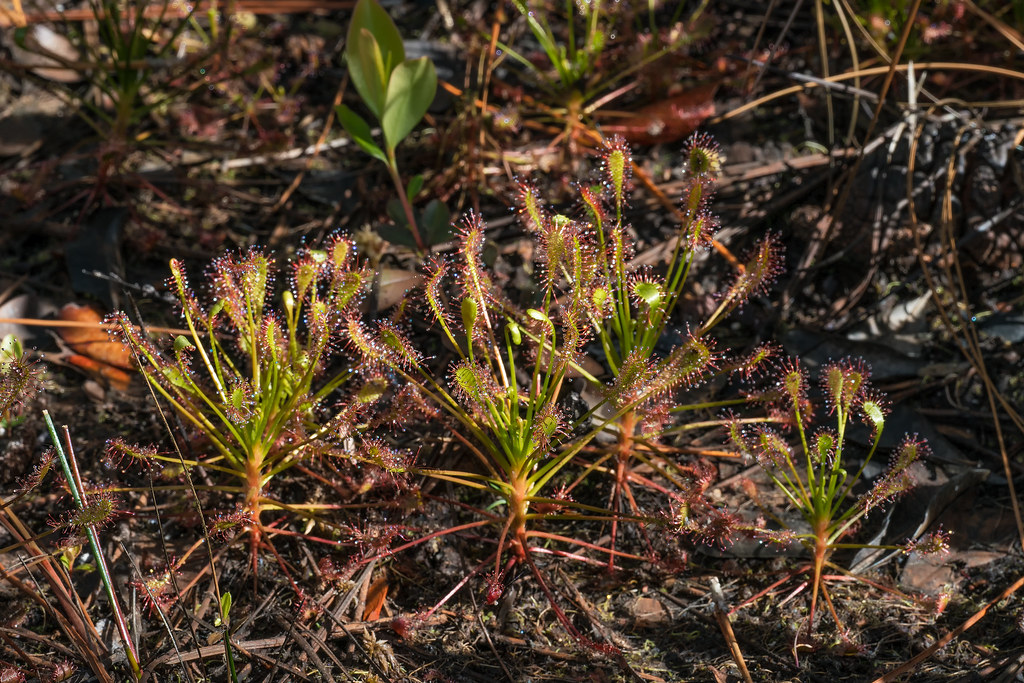
We would be seeing much more of this species as the day progressed
Our next stop would be Shoestring Savannah, just across the boardwalk connecting the western portion of Big Island with Shoestring Savannah. But just before arriving at the boardwalk, I smelled a very sweet fragrance which turned out to be a large Rhododendron atlanticum or Coastal Azalea just going past peak bloom. This is one of those flowering plants that announces itself with its strong floral fragrance oftentimes before it is visible:
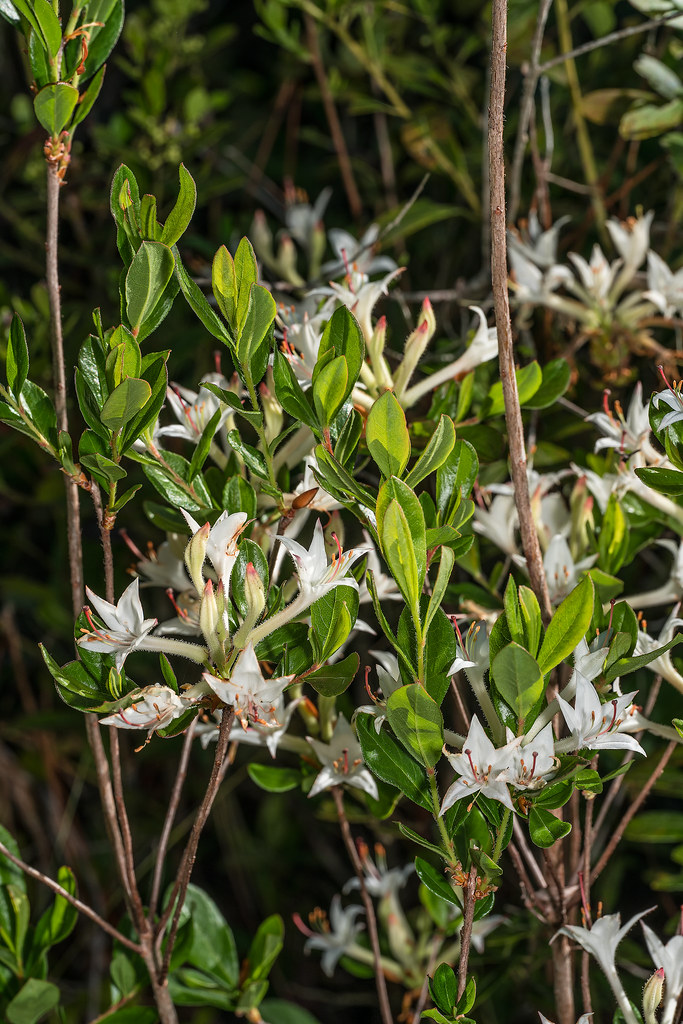
We entered the beginning of the boardwalk and wound our way through the dark pocosin. When we finally broke out of the dense pocosin into the bright sunlight of the open savannah, KT asked Hope, who had never seen Dionaea muscipula or Venus’ Fly-traps if she could see any. Well, there they were, at our feet, in full glory and in bud. The flowers had not yet opened, but she didn’t care. Hope could hardly contain herself with the possibility of seeing these strange plants for the first time! It’s great to be with someone who has such a wonderful experience as this. She would be reliving this feeling many times during the day…
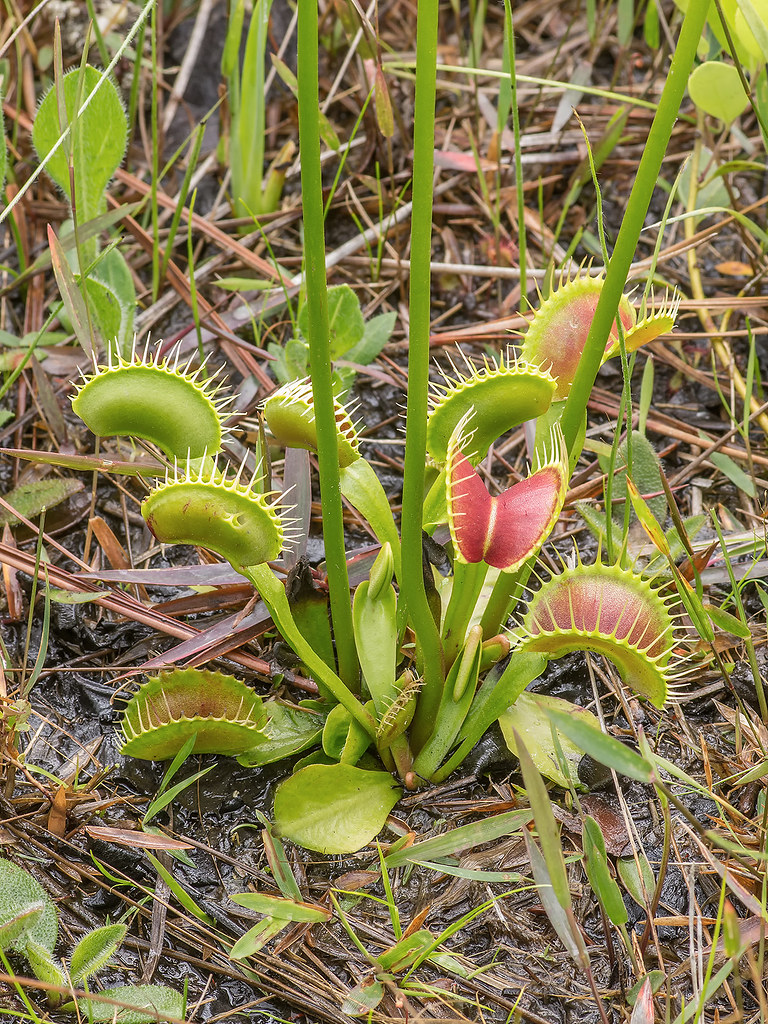
We wandered along the trail a bit until I saw some Chamaelirium luteum or Devil’s Bit aka Fairy Wand. I normally see this in the Carolina mountains, but it was a pleasant surprise to find it nestled in some tall ferns in the middle of the Green Swamp:

The day was definitely getting off to a good start.
We walked farther into the savannah when Melissa pointed out what looked like the large flower scapes of a grass species. She wondered what it was. Upon closer inspection, I was shocked to see that this was the flowering stalk of a native “bamboo”! The species was Arundinaria tecta or Switch Cane! As I understand it, these canes bloom only every 5 to 40 years — sometimes spurred on by fire. It makes sense because this savannah was just burned this past winter. This was my first time to see it in flower — I was beginning to feel some of the same excitement that Hope was feeling:

As we trekked farther on, I was imagining the upcoming (hopefully) show of our target species: Coastal Plain Pogonia. We rounded a corner and KT pointed out a group of three of the orchid plants still in tight bud. Fingers and toes crossed; we walked a bit farther. Then, in his own inimitable way, he hooted, meaning that he had found some of the orchids with open flowers. Great! Just what we had all come to see. This delicate orchid is a “cousin” to its larger counterpart, Cleistesiopsis divaricata or Large Rosebud orchid, which I hoped we would also find in the Preserve. In past years, we had found, at most, only a handful of the Coastal Plain Pogonia orchids in bloom scattered around in the Preserve, but today, we would see dozens of them — some in full bloom, some still in bud. Here is a sample of dozens of images I took of these beauties:
 |
 |
 |
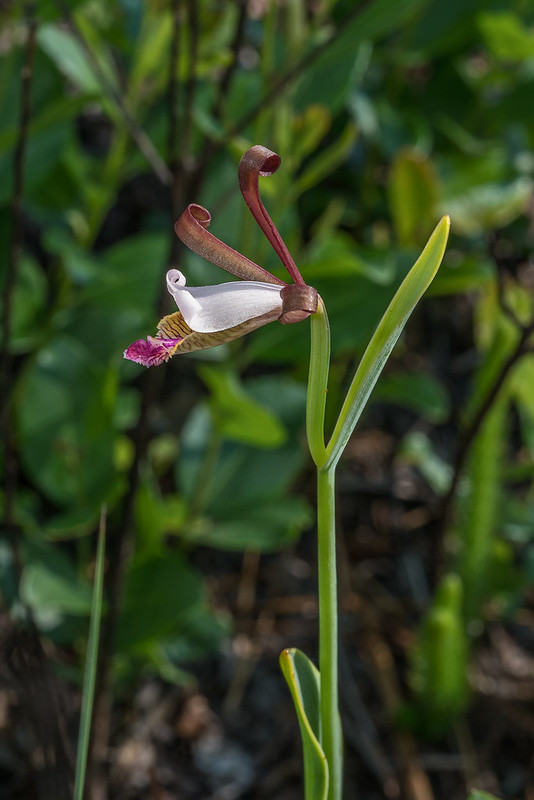 |

Note: This species used to be lumped in with Cleistesiopsis bifaria or Small Spreading Pogonia orchid, a strikingly similar species that is found in the mountains and foothills of the Carolinas. Only relatively recently was it separated into its own species.
Just a few feet (1 meter or so) away, were the tall, gracefully swaying stems of Amianthimum muscitoxicum or Fly Poison. It got its common name from a concoction that was made from its ground-up roots/bulbs and a bit of honey. This was supposedly a good remedy for house flies. The bulb of Amianthium muscitoxicum is very poisonous — not only to flies, but to people, as well. This plant contains toxic alkaloids in all its parts:

Nearby, (this was an especially productive area) we saw several Lysimachia asperulifolia or Rough-leaf Loosestrife plants in bloom. These bright yellow flowers are a sight for sore eyes. According to the U.S. Fish & Wildlife Service, “This species generally occurs in the ecotones or edges between longleaf pine uplands and pond pine pocosins (areas of dense shrub and vine growth usually on a wet, peaty, poorly drained soil) on moist to seasonally saturated sands and on shallow organic soils overlaying sand. Rough-leaf Loosestrife has also been found on deep peat in the low shrub community of large Carolina bays (shallow, elliptical, poorly drained depressions of unknown origin). The grass-shrub ecotone, where rough-leaf loosestrife is found, is fire-maintained, as are the adjacent plant communities (longleaf pine – scrub oak, savanna, flatwoods, and pocosin).” That is exactly the habitat in which we found it. Being listed federally as Endangered, this rare plant is always near the top of my list when I visit the Green Swamp in mid-May:
 |
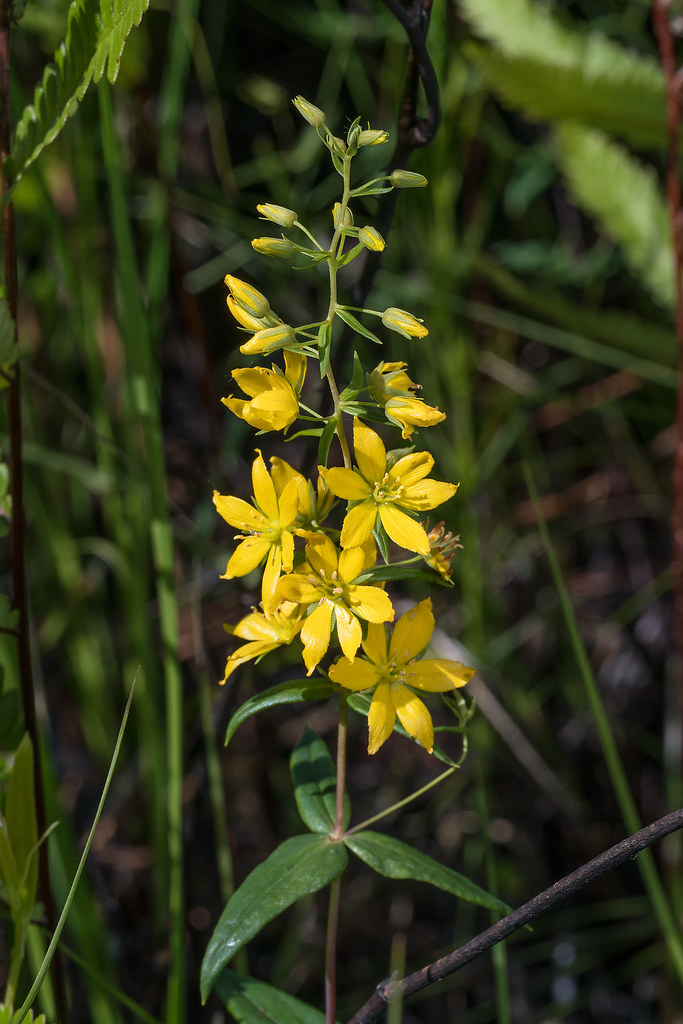 |
In the same area, KT pointed out a strange Pitcher Plant that I believe is Sarracenia Xchelsonii, a natural hybrid between Sarracenia purpurea subsp. venosa or Southern Purple Pitcher Plant and Sarracenia rubra or Red Pitcher Plant. Both putative parents were within spitting distance. This is a very rare hybrid in the Green Swamp due to the disparate bloom times of each of the parent plants:

We backtracked a bit and then proceeded farther into this rather large savannah. KT pointed out the beginnings of a large population of Calopogon pallidus or Pale Grass-pink orchids scattered out through the savannah. Although they can be found in the Spring and Summer in almost every longleaf pine savannah in the Green Swamp, they do respond particularly well after a prescribed burn. We would see hundreds of them during the day. So, it was difficult to pin down just which ones we would photograph. Here is a smattering of the many images I made of this rather small orchid:
 |
 |
 |
 |
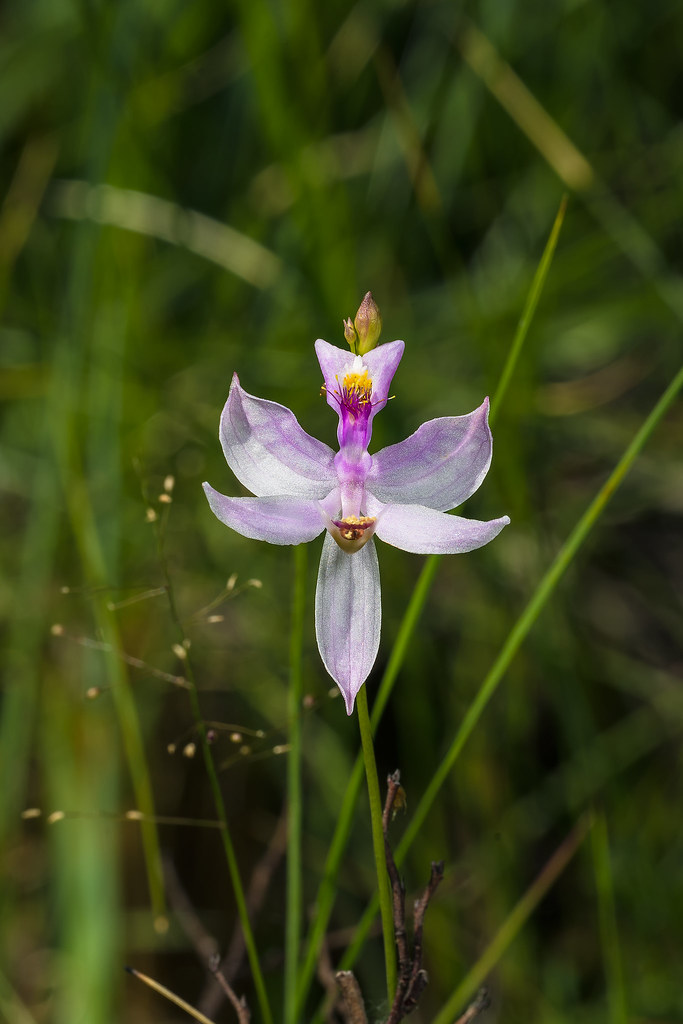
The color forms of this orchid species are quite amazing, and I can never get enough of them.
As I was stumbling around on the uneven grassy knobs of the savannah and trying my best to keep some semblance of balance, I spotted a flash of pink out of the corner of my eye. What is this? — a small group of Cleistesiopsis divaricata or Large Rosebud orchid. Jeff Jackson and I had seen just a few open flowers of this species in the Francis Marion National Forest the previous day, so it was a welcome sight to see additional open flowers in the Green Swamp:
 |
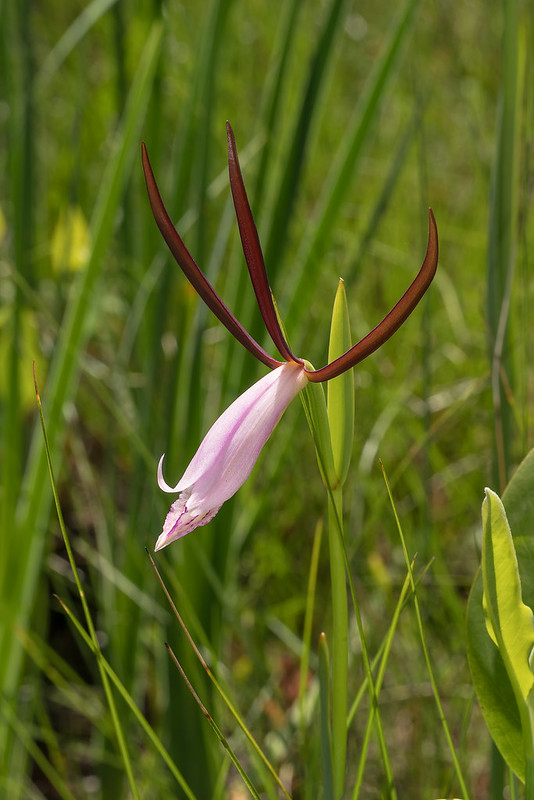 |
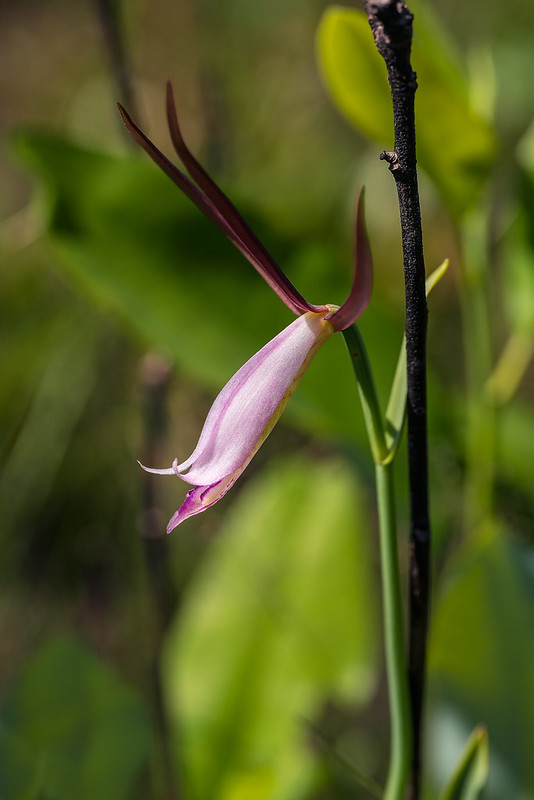 |
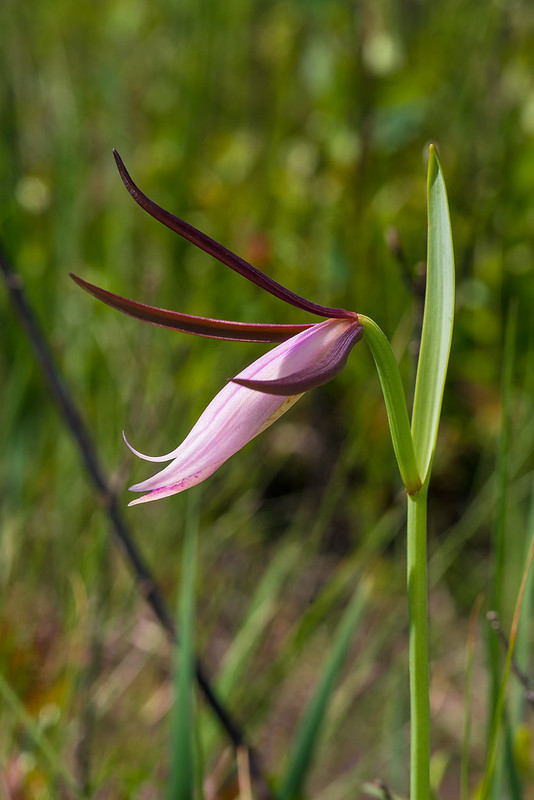 |


A rare sight, indeed, in the Green Swamp Preserve is Sarracenia minor or Hooded Pitcher Plant. Although it is the second most common Pitcher Plant in the Francis Marion National Forest just a couple of hours south, to find one in flower here is amazing. While photographing the Pale Grass-pink orchids, I saw a couple of bright yellow flowers poking just above the tops of the savannah grasses. It is one of the last of the 4 species of Pitcher Plants to bloom in the Green Swamp — all the others had finished. So I hollered to the rest of the group to tell them of my find. They all were excited to see this rather rare occurrence. Here are some of the images of a couple of the Hooded Pitcher Plants in the vicinity:
 |
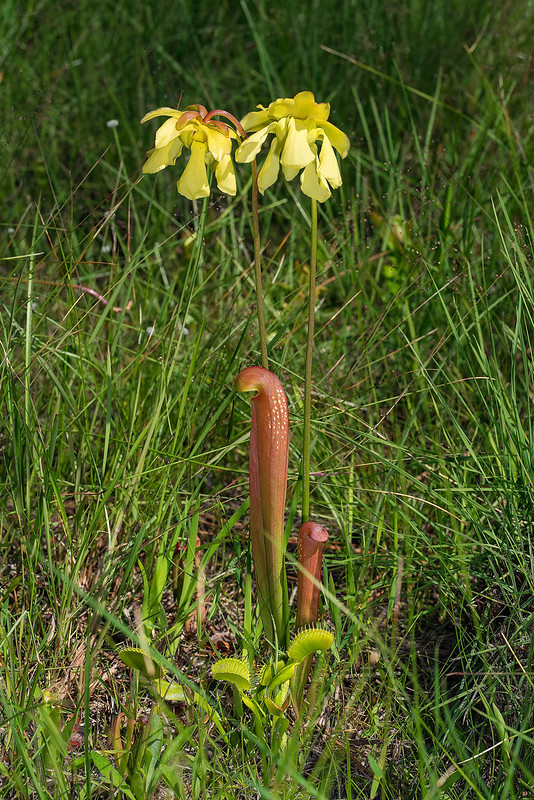 |
Note: In the image, upper right, there is a Venus’ Fly-trap at the base of the Hooded Pitcher Plant. This removes any question about where this image was taken…
Here is the rest of the group (left to right: Hope, Melissa, and KT) having their way with the Hooded Pitcher Plant:

Although not particularly remarkable for a Copper-top Pitcher Plant, I thought this single pitcher standing among a group of Erigeron species flowers or Fleabane was worthy of a photograph:

In another section of the savannah near the pocosin edge, there were still a few Pinguicula caerulea or Violet Butterwort plants in bloom. This is another carnivorous plant which catches small insects on its sticky leaves:
 |
 |
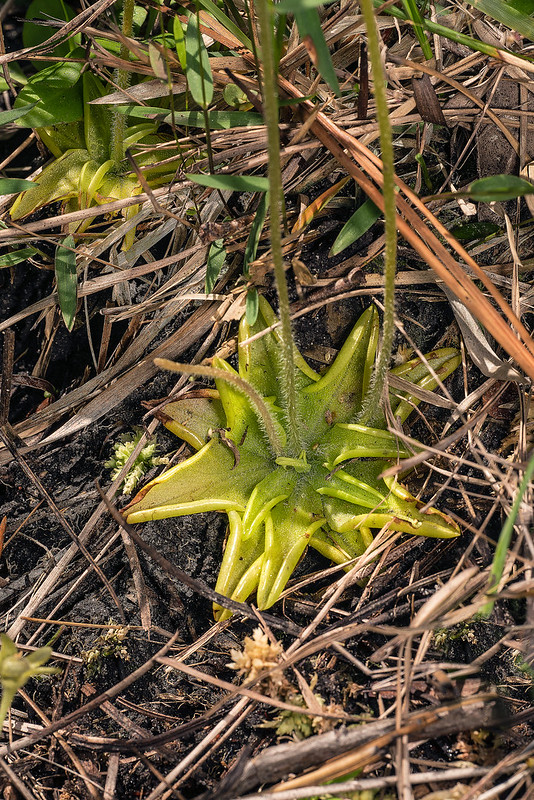 |
 |
The image above left shows the naturally curled leaves of Pinguicula caerulea.
Before leaving Shoestring Savannah, I wanted to photograph the tiny little Pogonia ophioglossoides or Rose Pogonia orchids we saw at the edge of the path. I had high hopes that we would see more of them later in Boiling Spring Lakes, but I’m of the “bird-in-the-hand” persuasion, and I didn’t want to miss out on an available orchid species:
 |
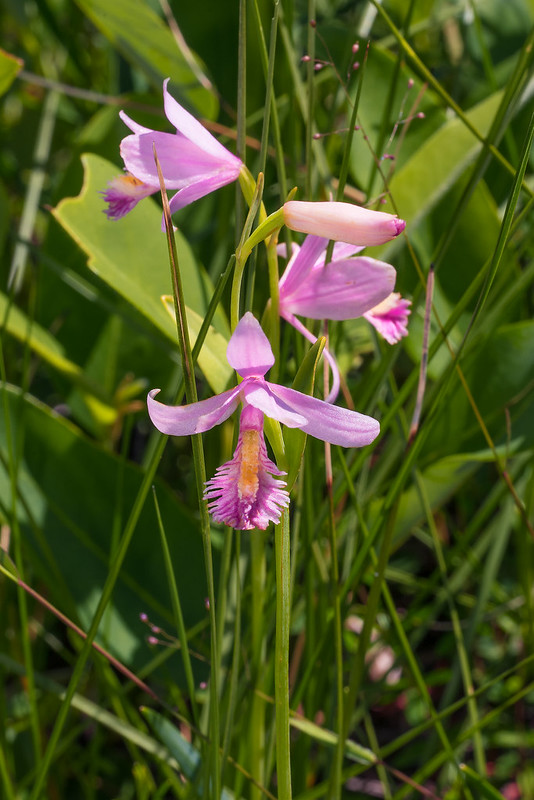 |
We packed our gear and headed back out of the savannah. Our next stop would be Big Island Savannah, just down the road. Melissa had been there during the fall of last year to sample some of the fall fringed orchids. One of her main duties at SERC is, in her words, “Using molecular techniques to elucidate questions about plant ecology. I primarily study the interactions of plants with their mycorrhizal fungi and the environment and how these interactions affect plant distribution and ecology.” So, this would be her first Spring sojourn into the same area where she had done her fall plant study.
We arrived on Big Island Savannah, gathered our gear, and headed off into the vast grasses. As we made our way around the savannah, I pointed out the Venus’ Fly-traps and Butterwort plants that are normally hidden under the thick sea of wire grass. Having been burned this past winter, Big Island Savanna was like a park with widely spaced longleaf pines surrounded by an impenetrable pocosin. Here’s a picture I took several years ago of this wonderous place:

As we neared the firebreak track near the edge, I spotted more Drosera intermedia or Spoon-leaf Sundew glowing in the bright sunshine:
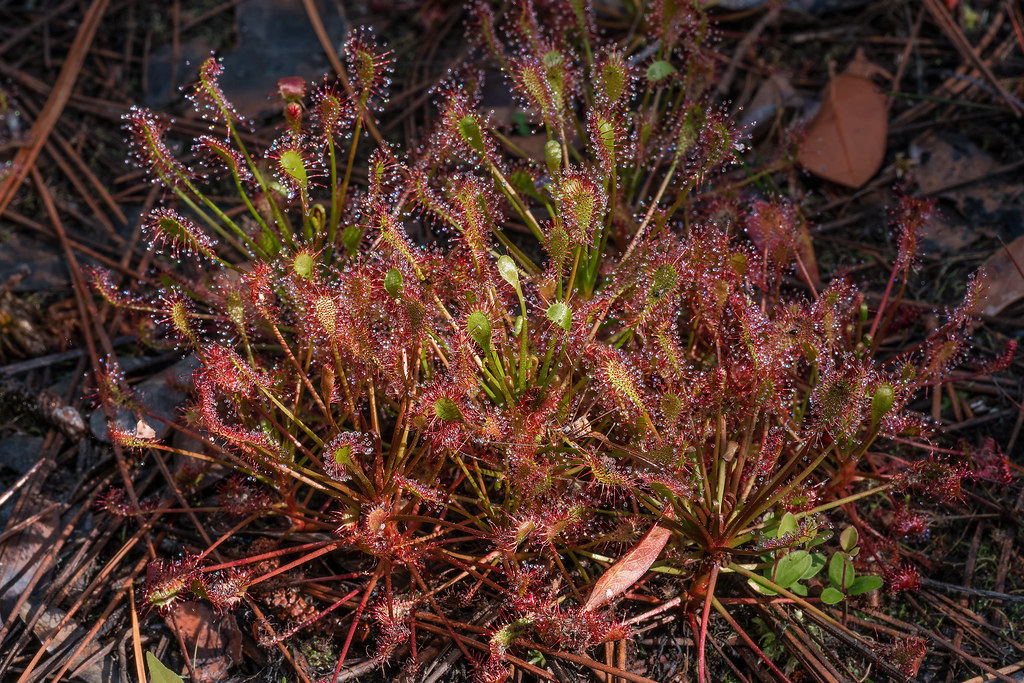
Just a short distance away was a painfully bright red cluster of Drosera capillaris or Pink Sundew. It’s amazing how red these plants can get in full sun:
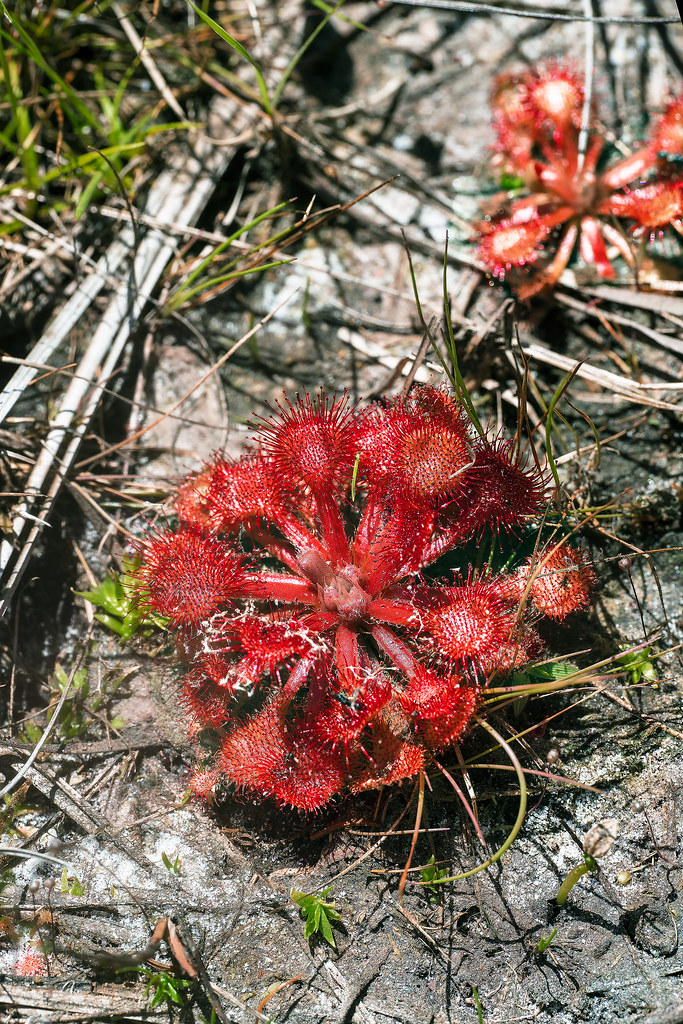
KT also spotted a few Violet Butterworts, but this time, they were nearly white:

We still had one more location to travel to, so we headed back to our vehicles. On our way out of the savannah, we spotted additional Calopogon pallidus or Pale Grass-Pink orchids. Among these was the white form of this species with no sign of pink or purple on the flowers:
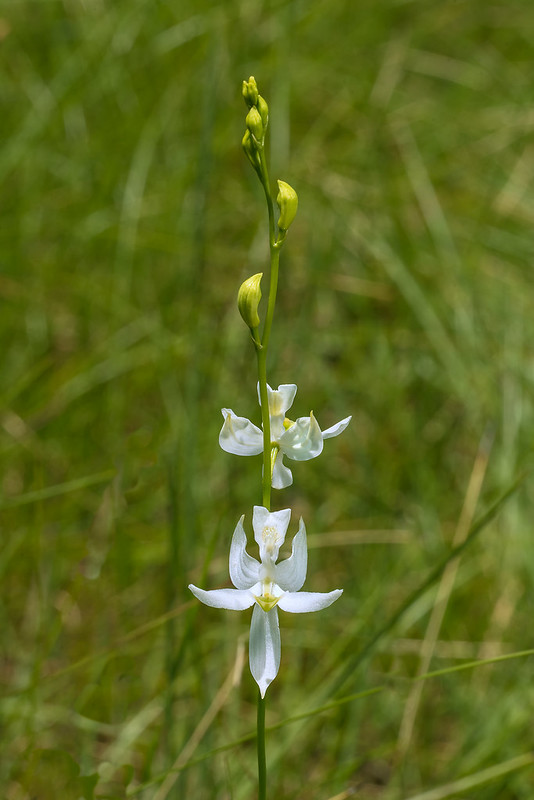

Nearby, KT spotted the only Calopogon tuberosus or Common Grass-pink orchid we would see in flower. It was still a week or so early for them:

It was about lunch time, so we made our way to the small town of Boiling Spring Lakes and found a pizza place that was open on Sunday. The food was great (we were all very hungry from being out in the field), and we spent an hour or so talking about what we had seen and sharing tales of other field trips. After lunch, we drove the few miles to an area that is owned and managed by the Nature Conservancy. It is mostly a roadside botanizing area where Venus’ Fly-traps and Rose Pogonia reign supreme. In addition, there were a good number of Coastal Plain Pogonia scattered about the roadside margin. What a treat! More orchids! Here are some shots of what we found:
 |
 |
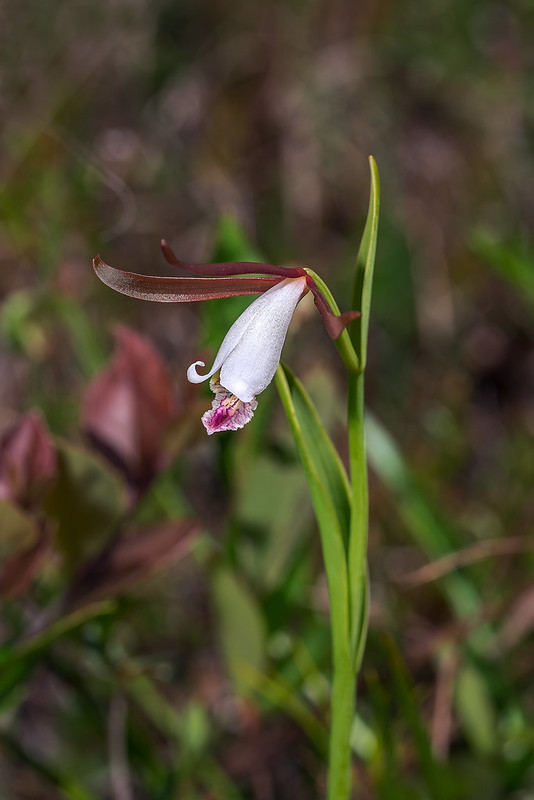 |
 |
The place was so tightly packed with wildflowers, that it was nearly impossible to move around and not step on something important. There were more Rose Pogonia orchids than you could shake a stick at. They were just everywhere. Here are some of those pink beauties:
 |
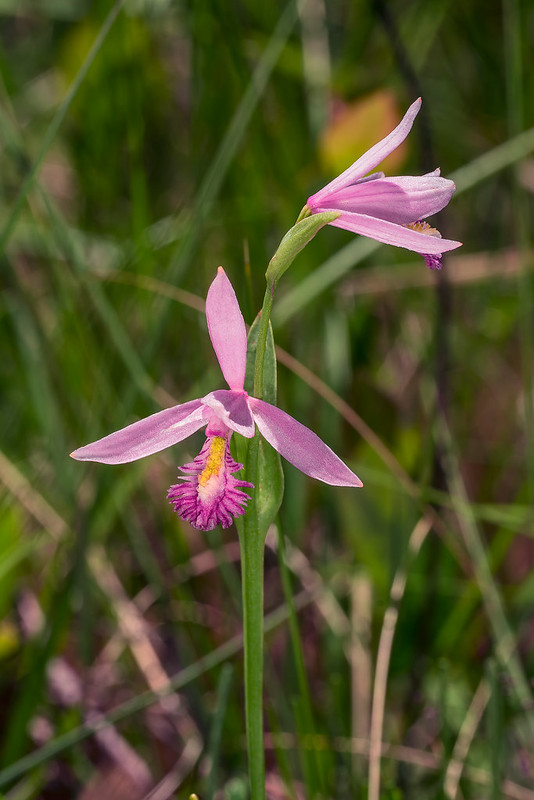 |
KT and I had joked about finding the white form of the Rose Pogonia orchid, but Melissa actually found one!:

There were also a few Venus’ Fly-trap flowers beginning to open:
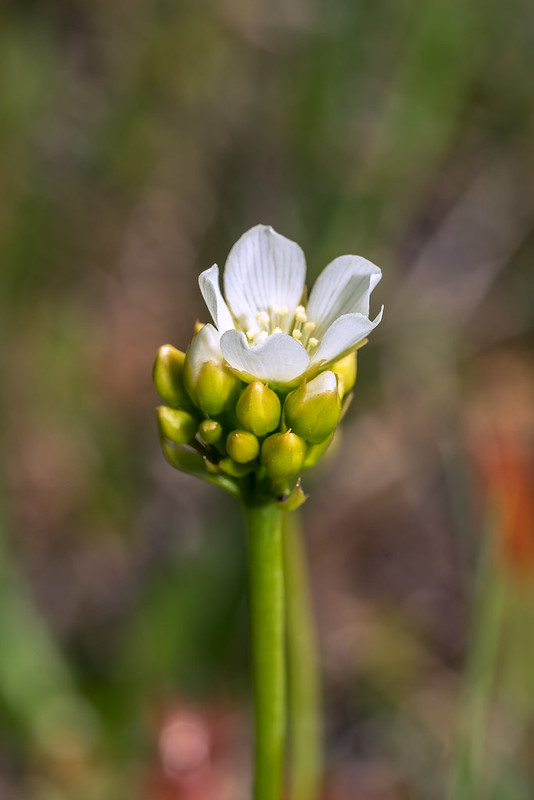 |
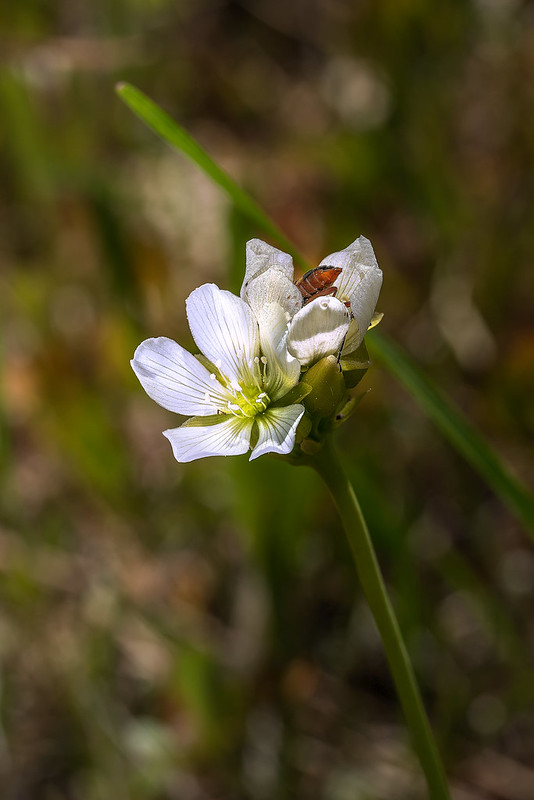 |
I’m sure the bug is a lot more comfortable in the flower (image, upper right) than it would be in a trap!
Scattered around in pretty good numbers were the bright orange flowers of Polygala lutea or Orange Milkwort. We even found a few (out of thousands of the typical orange ones) bright yellow flowered ones:
 |
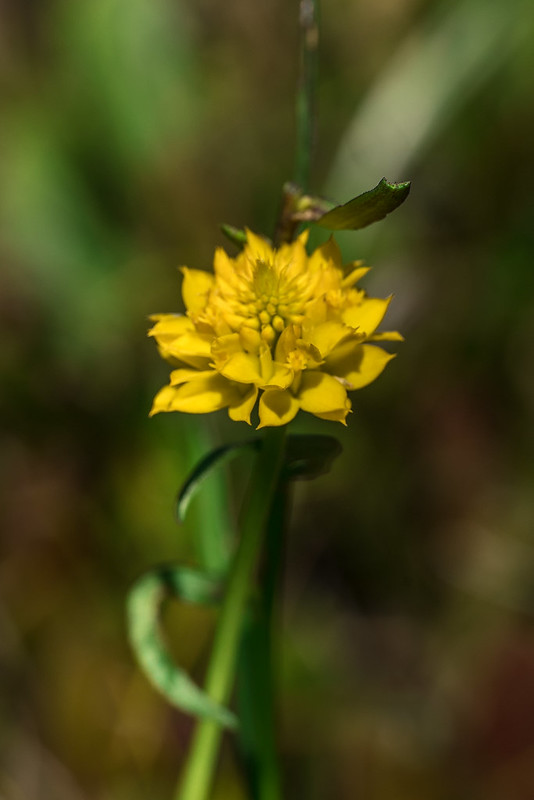 |
We spent a long time at this site — there were so many orchids and other wildflowers to see and photograph. But, I had a 5.5 hour driving trip ahead of me, and I wanted to get home before dark. There was one other spot, just down the road, that I wanted to show Melissa and Hope before we parted. This spot is a rather deep ditch which was currently dry because of lack of recent rain. But it usually has an unbelievable number of Rose Pogonia orchids in it. Eventually, I suppose, it will be filled in as progress moves onward, but for now, it is a glorious sight which I cannot really capture perfectly. But here is my best attempt:

I was actually standing in the middle of the ditch when I took this picture. There were as many more orchids behind me as were in front of me.
Finally, before I left, I wanted to get a shot of Melissa and Hope with the orchids. So I posed them at the edge of the ditch:

I suppose you are suffering from wildflower/orchid overload at this point. I know I am. It has been a great year, so far, for native orchids and wildflowers in general. I live in an area that is considered to be one of the most diverse botanical regions in the U.S. And I feel so fortunate to be able to share it with you folks. There is a lot to be said for botanizing in the Southeast, but botanizing with friends makes it even better.
I’m not sure what field trips are on the horizon for the rest of the month or for early June. I guess we will just have to see… Thanks for sticking with my rambles through the end of the blog.
Stay tuned, until then…
–Jim

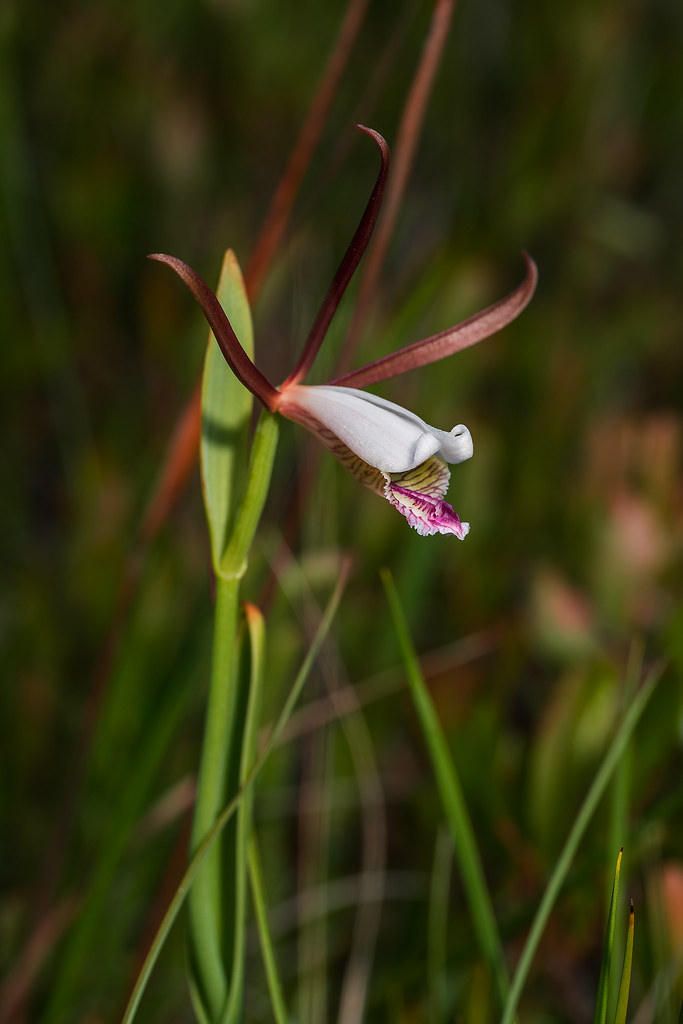
7 Responses
Absolutely fantastic! Thanks for sharing!
Wow! What a day! What a day filled with finds! Great work, muchly appreciated!
Your photos are simply gorgeous! I never miss checking them out when your emails come!
Orchids, carnivorous plants and more, OH, MY. What a colorful trip and quite a lot for us to see. On to your flickr to fave a few!
My jaw dropped ten feet when I saw that last “ditch” stop filled with Rose Pogonia orchids! I must make a trip there to experience the wonder! And I’m still not settled about the Cleistesiopsis orchids that I found on my land. I’m not convinced yet whether they are oricamporum or divaricata…surely there must be other differences than vanilla scent?? Are their DNA genomes identical?
Also, has anyone measured soil pH whenever white flower forms are found among prevailing pink populations?
fabulous report what an amazing day.